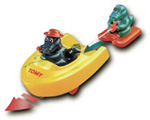|
|||
| Introduction | |||
| Childhood games and toys | |||
| ASSESSMENT CRITERIA FOR TOYS There have been various criteria to classify toys, usually linked to a given theoretical position. In this sense, among the first ones we find the classification of Bühler, one who states that toys could be structured in three types: Toys designed for movement and motor activity, leading to the muscular development. Construction toys and creative games that mark the beginning of the conquest by the child of the materials that surround him/her. Toys used for dramatic action, fiction, and imitation games that enable the child to penetrate in the world of fantasy. Bühlerís classification, apparently very simple and not very up-to-date points out some interesting things to be considered, and that we should return to when we assess the links between toys and the stimulation of intelligence.
J. Piaget establishes a classification of games and toys mentioned at the beginning of this essay, that is very organic and consequent with his theory of the development of knowledge, so it reinforces the focus towards the intellectual sphere. There are different classifications that refer to chronological ages, relating a series of toys appropriate for a certain stage of development, and so we have toys for nurselings, for the early years, for pre-schoolers. This type of classification has many limitations, because as we said before, age can only constitute a general guide and it is more important to assess the processes and psychological features promoted in a certain stage of development and stimulated by a type of toys. These classifications are based mainly in the processes and qualities in which they intervene, for example:
Another similar classification, in the conceptual line of H. Page, is the following one:
These classifications are based on the stimulation of certain processes and qualities, but they don't contemplate all the possible potentials to be stimulated, nor all the areas of development. Nevertheless, their main conceptual principle, to stimulate essential psychological or physical actions, is a good direction in the study of this issue, and it is closely related to modern positions, connected with them in a very natural way. This will be proven when we analyse a different way to classify the toys, based on the theory of the multiple intelligence of H. Gardner. The final conclusions of this essay will come from this point of view.
|
||||||||||||||


